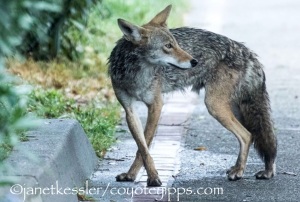
walking down the middle of the street in San Francisco
Some of our coyotes are dispersing right now as their parents prepare for the next breeding season. Usually between the ages of 1-3, coyotes disperse: they leave their birth homes to make their own way in the world. A coyote may be forced to leave by a sibling or parents, or it may leave on its own. As they explore new areas where they have not been before, you might see one — hurrying through a neighborhood, either down a street or on the sidewalks. They stick to these passageways because coyotes, just like humans, like taking the *path of least resistance*. When they find a place with adequate natural cover, they might try it out as a place to take refuge for a while.

on the sidewalks in the heart of San Francisco
They may live for the time-being without a territory and alone. Recently dispersed coyotes tend to live in smaller open spaces, and in-between and on the edges of other coyotes’ claimed territories, and they are not territorial. These individuals are called transients or interlopers. Transients include not only dispersed youngsters, but others who have been displaced from a family — even oldsters! Being social animals, they may get lonely and may at times seek out the company or achieve a mutual *truce* with amenable dogs although they are usually not quite willing to let down their guard totally to become friends.

traversing a San Francisco neighborhood
Please do not befriend them, and never feed them. As consummate hunters and opportunistic eaters, they are totally able to provide for themselves. Please let them do this. Instead of being friendly, give them the cold-shoulder. They will be safer and so will your pets if you keep this psychological barrier in-place.
And please remember never to feed coyotes: it could lead to their death warrants. Food conditioning, which results from feeding them, causes coyotes to hang around humans, and sometimes approach and demand food. Wild animals normally defend themselves from fright, a startle, or anything else by nipping, and they will do so if provoked, even if you don’t think you are provoking them.

In alleyways
They will, of course, continue looking for a territory which has not already been claimed by another coyote family, or one that has been vacated for a number of reasons by another family.
Note that, once the carrying capacity of an area is filled, such as in San Francisco, coyotes move out of the city and south, where they have been found as far away as 60 miles within just a week or so. Dispersion is a high-risk time when more coyotes than usual are killed by cars. Please be careful when you drive.

finally, she comes to a natural open space where there is natural coverage for her to hide in. San Francisco has plenty of these small havens.



 Dear Community —
Dear Community —
















